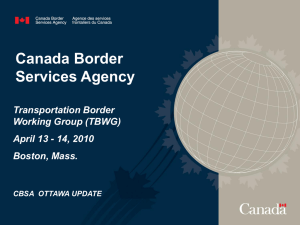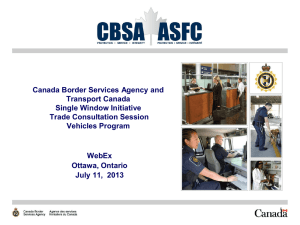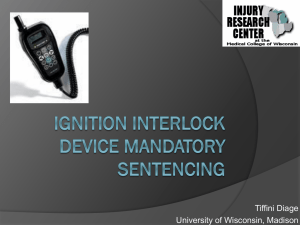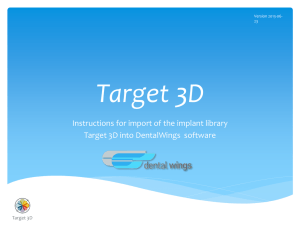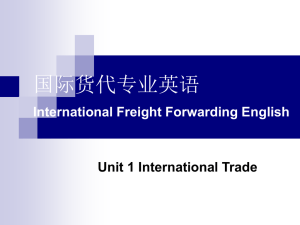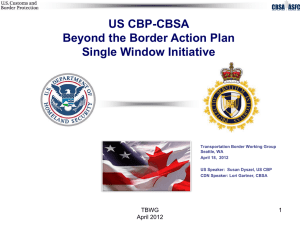Health Canada
advertisement
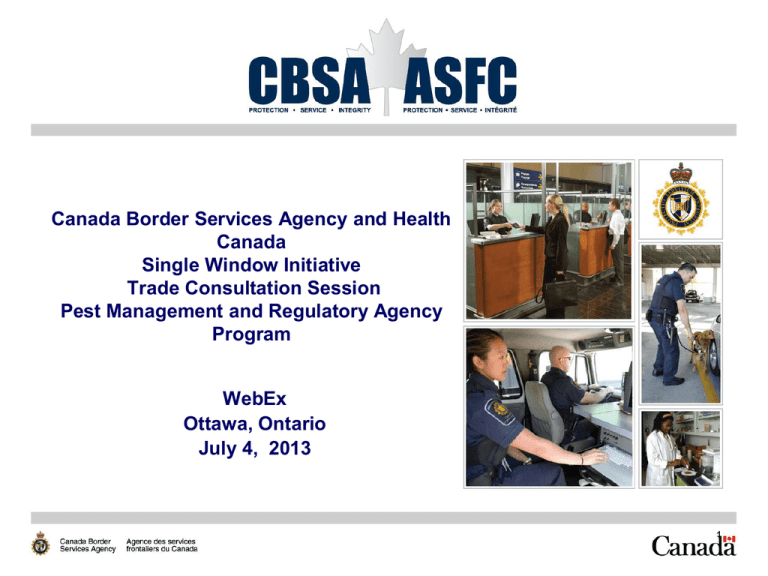
Canada Border Services Agency and Health Canada Single Window Initiative Trade Consultation Session Pest Management and Regulatory Agency Program WebEx Ottawa, Ontario July 4, 2013 1 Topics • Background on the Single Window Initiative • Defining Success • Opportunities • Single Window Initiative Development • Pest Management Regulatory Agency (PMRA) • Current and future processes • Additional data elements • Enhanced Commodity Identification • Projected benefits for Trade and PMRA • Next Steps • Questions and Answers 2 Introduction • The Canada Border Services Agency (CBSA) considers the involvement of stakeholders in the design of the Single Window Initiative (SWI) to be critical to its success. • Trade Stakeholders have the opportunity to provide input and feedback on: • Integrated Import Declaration including data requirements; • Proposed enhanced commodity identifiers; • Border Process Modernization. 3 Single Window Initiative • CBSA-led initiative to provide trade with a single entry point for the advance electronic reporting of import information required to satisfy CBSA and Participating Government Agencies (PGA) requirements. • Involves the development of a more efficient, effective and integrated approach to collecting and consolidating Government of Canada (GoC) advance commercial information required on all imported goods. • Responds to calls for action by the trade community to simplify processes at the border by reducing paper burden and integrating PGA requirements into current CBSA import processes. • Provides integrated solutions for commercial processing that balance the needs of the GoC with today’s globally competitive business environment. 4 Defining Success A more integrated border process whereby: • Canada and the US achieve an increased measure of data harmonization for imports into both countries. • Traders are provided with a single window in each country through which they can electronically submit all information to comply with Customs and other government import regulations. • Data requirements are converted to electronic form using Customs import data collection mechanisms, minimizing the requirement for paper requirements in the import process. • Improved trade facilitation and increased efficiency are achieved through the use of electronic data interchange. 5 Opportunities • Perform a review of regulatory requirements with emphasis on modernizing how and when regulatory requirements are applied; • Centralize import data collection and share data with departments and agencies. • Involve trade in the design in order to capitalize on current trade practices and business solutions; and • Modernize business processes for the importation of regulated goods. 6 Business Process Modernization Better quality, more accurate and more timely information collected through the IID will: • Eliminate manual and paper-based processes required for border compliance; • Convert border processes to electronic format; • Allow PGAs to more accurately and efficiently identify their regulated shipments; and • Move compliance verification activities to an appropriate point in the import process (e.g. post-border), allowing for expedited border processes. 7 Integrated Import Declaration • The IID will be developed as an Electronic Data Interchange (EDI) message • Enhance existing CBSA release processes to include all Government of Canada (GOC) data required for the importation of commercial goods; • Include only data that is essential to make border-related decisions; • Eliminate the requirement for paper documents at the border where possible; • Enable trade to use product identification methods available within their supply chains; • World Customs Organization (WCO) compliant; and • Aligns with CBSA eManifest ATD requirements. 8 IID Benefits • Transmission of PGA import data through IID provides benefits to Trade and Government through: – Elimination of presentation of paper License, Permit, Certificate or Other (LPCOs) at Border; – Elimination of redundant data; e.g., no longer need to identify Importer of goods multiple times through various processes (Permit application, CBSA import process, permit verification, post-border verification); – Meet verification of Licenses/Certificates (e.g., Establishment Licences, Market/Product Authorization) requirements by presentation of data element(s) in IID; and – Improved data quality resulting in more certainty at Border • Issuance of RFIs to allow re-transmission and acceptance prior to the goods arrival at Border. 9 Import Data Elements • Data elements include the CBSA Release and Participating Government Agencies (PGA) Admissibility / Release requirements. • No new information will be required beyond that which is required today in the importation processes o Ongoing analysis is anticipated to lead to a further reduction. • The PGA requirements are in most cases commodity-related (e.g. commodity lot number, commodity physical state, etc.). • New fields have been included to capture authorization information where still required (e.g. permit number, license number, etc.). • Fields to capture commodity identification enhancements. 10 Business Processes Improvements • Using the IID for the pre-arrival collection of import permit information. • Eliminating a separate permitting process. • Verifying pre-approved authorizations for permits and licences. • Validating a permit / license / certificate number through the IID. • Pre-arrival admissibility recommendations on IID information referred to HC/PHAC for referral. • Post-border review for compliance. 11 SWI Electronic Commerce Client Requirements Document • The SWI IID ECCRD provides external system users with comprehensive information of requirements related to the Electronic Data Interchange (EDI) SWI IID system – – – – – SW Project background, goals, etc; Business Rules and Transmission requirements; Data Element Glossary; IID GOVCBR message structure; Data maps inbound/outbound (Message Implementation Guide) • XML and EDIFACT formats; – Technical systems requirements; – Certification and Testing requirements. 12 Product/Goods Identification Opportunity • Identifying goods using internationally accepted, wellmaintained and industry-accessible identifiers will benefit both PGAs and trade. • More accurate identification of goods allows PGAs to facilitate low risk shipments across the border. • Sector-specific identifiers are being considered such as: – Global Trade Item Number (GTIN) – Chemical Abstract Service Registry Number (CAS) – Taxonomical Serial Number (TSN) • It is anticipated that multiple identifiers may replace existing permit information and reduce the overall amount of data required by industry at the border. 13 Pest Management Regulatory Agency 14 Pest Management Regulatory Agency • Health Canada’s Pest Management Regulatory Agency (PMRA) is responsible for pesticide regulation in Canada. • Pesticides are stringently regulated to ensure minimal risk is posed to human health and the environment. • Pesticides are regulated under the Pest Control Products Act. 15 PMRA - Current Import Requirements • All pest control products imported into Canada must meet Canadian standards and must bear the Canadian Label. • Pest control products must undergo an assessment by PMRA before they are eligible for registration in Canada. • Registered products are assigned a Pest Control Product Registration number. • Importations of many pest control products require a paper based Form 6018 (Declaration by Importers of Controls Products) which must accompany the shipment into Canada. • A GROU import certificate, Form 6200, is required for all importations of GROU approved products and must accompany the shipment into Canada. • A GROU approved container label must accompany the shipments. • Importers do not provide PMRA any documentation for the importations post border. 16 PMRA Benefits • The Single Window will validate, pre-arrival, the required data elements for the importation of goods regulated by PMRA including: • the pest control registration number; • research authorization number; • research notification certificate number; • own-use certificate numbers; and • inclusion of the CAS registry number as an enhanced commodity ID. • This will eliminate the need for the importer to provide paper copies of the Import Declaration (PMRA Form 6018) and GROU Import Certificate (PMRA Form 6200). • Single Window will validate scheduled and exempted products against the Pest Control Product Regulations (PCPR). • These classes of pesticides are exempt from registration. • Single Window will assist the PMRA, through digital imaging, with verifying information before the shipment arrives at the border. • An electronic image of label information may be included in the IID. 17 Trade Benefits • Eliminate the need for the importer to provide a paper copy of the Import Declaration (Form 6018). • Eliminate the need for the importer to provide a paper copy of the GROU Import Certificate (Form 6200). • Timelier release recommendations by validating information against enhanced commodity information. • Allow for electronic notification to the importer when a shipment has been referred for detention. 18 19 IID Business Views The IID Message structure consists of three main levels: • Declaration Level: – used to provide information that pertains to the entire declaration/document. • Goods Group Level: – to provide "shipment/invoice " level information that pertains to various defined pieces of the information found at lower levels of the message structure, such as Commodity/line level information. • Commodity Detail Level: – to provide the traditional "line level" goods item detail. • The IID message structure aligns with the CBSA’s eManifest ATD message structure to support CBSA commercial process modernization efforts. 20 PMRA IID Business View 21 IID Business Glossary 22 IID Business Glossary • The ECCRD contains a business glossary of data elements providing information on the CBSA names/definitions, WCO names/definitions and conditions of use. Data Element Name Message Function, coded Definition WCO Data Element Name WCO Definition Code supplied Message Code indicating the by the Function, function of a coded originator to document. identify how the transaction is to be processed. Conditions of Use: M = Mandatory C = Conditional O = Optional M Code 1 = Cancel Code 9 = Add/Original Code 4 = Change Code 5 = Amend 23 PMRA Data Elements In addition to the CBSA release requirements that exist today, the IID for PMRA regulated goods will include the following PMRA required data: •CAS Number •Certification Document •Certification Number •Guaranteed Concentration •Product Description – Active Ingredient Guarantee •Quantity – Unit Size •Product Description – Active Ingredient Name •Registration Document •Label Image •Product Description – Product Name •Manufacturer Name •Purpose of Importation •Manufacturer Address •Quantity – Unit Type •Registration Number •Research Authorization Number •Research Authorization •UNDG Code 24 Enhanced Commodity Identification • The PMRA’s requirement is to receive better information specific to identifying a commodity/product beyond the HS code. • The PMRA is proposing the use of a Chemical Abstracts Service (CAS) Registry Number as a commodity identifier. • Better commodity/product identification reduces the amount of information required during the import process. 25 Next Steps • Review and discuss the data requirements and border process reengineering with your industry members. • Address questions and comments regarding PMRA import requirements to Vital Hagenimana. • Address questions and comments regarding the new PMRA border process to Marnie McKinstry. • Continue to support SWI and its consultation activities. 26 SWI Contacts Marnie McKinstry CBSA A/Manager - SWI Business Design and Development email: Marnie.McKinstry@cbsa-asfc.gc.ca Katherine Jenkins CBSA A/Manager - SWI Trade Consultations email: Katherine.Jenkins@cbsa.gc.ca David Pellmann HC/PHAC Project Director - SWI email: david.pellmann@hc-sc.gc.ca Terry Byars CBSA Senior Program Advisor - SWI Business Design and Development email: Terry.Byars@cbsa-asfc.gc.ca Single Window Generic Mailbox: SWI-IGU@cbsa-asfc.gc.ca 27
